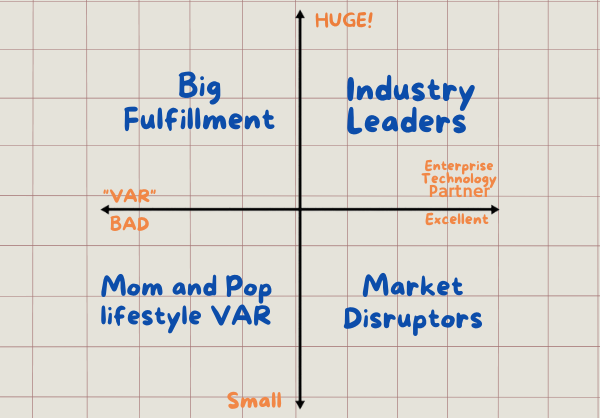Getting your IT infrastructure right is one of the most important decisions you can make for your company. It can increase efficiency and productivity, help you take advantage of business opportunities, and improve the user experience for customers and employees.
Getting it wrong also has consequences. You can add new levels of frustration for everyone, lose business, and prevent the company from competing the way it should. It becomes a speed limit on your path to success, and an obstacle to productivity. And at its worst, it can be the reason the business fails.
But it doesn’t have to be that way.
There’s no successful “one size fits all” approach in the area of Information Technology. On one hand, it takes a bit of effort to make sure the infrastructure fits what you’re trying to accomplish. But on the other, once you have it in place, it’s custom-created to make things easier for you, your team, and your clients and customers. It can be designed to maximize your resources today, while growing with the company tomorrow. And because so many companies don’t give enough thought to setting up proper infrastructure (or don’t know how), it becomes a competitive advantage for you as well.
Here’s how to make sure you have the right IT infrastructure in place:
Available Options
It’s hard to pick the right solution when you don’t know what they are. Today, you have a few different options that could meet your IT needs.
- In-House vs Third-party solutions. You could have an on-site team of IT employees whose job is to make sure the network is running smoothly and problems are fixed immediately, or you could let a third party handle it for you. Issues of cost and your company’s needs will play major roles in determining which option works best for you. And, like many of the options presented here, there’s the issue of how much control you want to have within the company as opposed to letting someone else run the infrastructure. There are positives and negatives associated with working with an infrastructure partner as opposed to handling it all yourself, and the unique circumstances will help determine which option is the right one.
- Cloud Management. In recent years, this consideration has evolved from “Do you need the cloud?” to “How will you manage the cloud?” Most companies will want at least some access to cloud benefits, and for many it will be absolutely essential.
You can choose to manage and operate your own cloud (private), utilize a third-party provider’s access (public), and purchase that access based on storage, bandwidth, or another metric. You can also utilize both options (hybrid), making some resources private and accessing whatever else you need from outside vendors.
- Using as-a-service models. Ironically, technological advances now allow businesses to become less involved in providing their technology needs than ever before. You could have state-of-the-art infrastructure and no IT department at all, and you can expand your company’s resources with a phone call.
The rise of the as-a-service model means companies can choose a subscription that meets their software (SaaS), platform (PaaS) and even their entire infrastructure (IaaS) needs without hiring extra employees or purchasing expensive hardware. You don’t actually own any of the technology, but you don’t own the maintenance responsibilities either. You also gain the flexibility of purchasing only what you need today and adjusting it as those needs change over time.
Assessing Your Needs
Deciding what type of IT infrastructure is right for your company can be deceptively difficult. While one option might have initial appeal, a careful analysis might reveal better choices. It’s important to give consideration to a number of factors before making a final decision. Some of those factors include:
- Business plan. What is the company trying to accomplish specifically? As a growing company (or a market leader), what type of infrastructure would put you in the best position to succeed? How would a different type of format help you accomplish your goals faster, and how would you overcome the drawbacks?
- Employee feedback. It’s important to get input from the people who will be using your IT infrastructure on a daily basis. What’s limiting them today, and what would help them do their job better? What technology frustrations could be solved with a different or updated approach? You might find that their concerns reveal challenges that weren’t considered at the executive level. Consulting with favored clients or vendors could be beneficial as well. If they’re impacted by your IT decisions, their outside view might reveal missed opportunities or obstacles your team hadn’t considered.
- Existing IT assets. Assessing your needs involves assessing what you already have. If you’ve already made a significant hardware investment, abandoning it entirely would be a costly and wasteful decision. But if you’re starting from scratch, or you know your IT assets are lacking, you have more freedom to go in a new direction. Incorporating what you have into a new plan (if possible) would be an efficient way to expand your opportunities while making the most of existing resources.
Gauge Your Growth
You want your IT infrastructure to work for you today, and be able to grow with you tomorrow. Reshaping your technology plan can take up valuable time and resources, so making the right decision includes not having it to do it again in the near future.
Asking if it works for you today isn’t enough. Will it work for you tomorrow? Is it easy to expand the infrastructure according to your needs? If you need to shift resources toward or away from the cloud, how difficult would that transition be? Can the company you want to have in five years compete with the IT infrastructure you’re considering?
Asking difficult questions now will save you time and money later. A plan that can grow with you is a valuable resource that will justify its costs as long as you have it.
Need More Help?
Important IT infrastructure decisions don’t have to be made alone. Imperium Data has the experience and resources to help you evaluate what you have currently, compare different options, and help you select what’s right for your business. Simply use our contact page to get started today.



